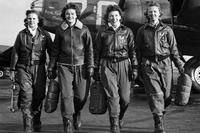Floyd Smith probably understood the importance of a controlled fall better than any pilot of his time. Before Smith was flying in the skies above Los Angeles, he was a high-flying trapeze daredevil in a circus act. It was where he met his wife and probably learned to keep his composure while free-falling to Earth.
Without that circus act and the accident that almost killed his beloved wife, Hilder, he might never have invented the backpack, ripcord, free-fall parachute, which earned him a spot in the National Inventors Hall of Fame in 2021.
Parachutes had been around for a long before Smith developed his chute in 1919. Leonardo da Vinci designed a pyramid-like chute in the 1470s. A successful chute made from modified umbrellas helped Louis-Sebastien Lenormand fall safely to the ground in 1783 -- the same year the American Revolution ended.
But Smith changed the game when he filed the patent for a backpack-worn, ripcord-operated chute that could be deployed independent of an aircraft. Smith had been in a trapeze act for five years before coming into aviation. It’s where he fell in love with Hilder.
He spent his later years blazing trails from a cockpit -- and, more importantly, outside of it -- with her. She might be the reason he started thinking about parachutes in the first place.
Hilder nearly died in a 1914 flight over the Pacific coast. Like most pilots at the time, she and her chute were attached to the airframe via a static line. When she jumped from the plane, it was supposed to deploy her chute and help her land safely.
Except those old static-line chutes required a near perfect jump from a cockpit, with a plane that wasn’t out of control. The only problem with that kind of setup is that people seldom need to jump out of a plane that isn’t out of control. When Hilder jumped, a twist of her body tangled the cords and prevented the canopy from fully opening.
It eventually opened, and Hilder miraculously landed safely. The close call gave her and her husband a lot to think about, however. Floyd quickly developed an interest in creating a parachute that would give pilots more control over how and when their chute opened, in case they couldn’t make a perfect jump for some reason.
Say, if they were shot down over the battlefields of Western Europe, for example.
By the time Hilder and Floyd Smith started developing parachutes, they had been in aviation for two years. They built their own aircraft and taught themselves how to fly it at a bean field outside Los Angeles. They had turned their aerial training into another kind of daredevil show and took it on the road as a barnstorming team. The duo flew in performances much higher than the trapeze ever was before coming back to Southern California in 1915. This is where Floyd Smith became an aviation pioneer (and the bean field he learned to fly in would become Los Angeles International Airport).

The U.S. military finally had begun to embrace air power as a weapon of war. What they had not embraced was the parachute. In England, which was in the full throes of World War I by 1915, military planners saw a parachute as a cumbersome burden, affecting engine performance while impairing “the fighting spirit of pilots and cause them to abandon machines which might otherwise be capable of returning to base for repair.”
Still, with Hilder’s close call still fresh in his mind, Floyd Smith was looking to create a more flexible chute that was better suited to an aircraft in distress, should the pilot want to bail out. In 1918, he created the “Floyd Smith Aerial Life Pack,” the first backpack chute that required the user to pull on a rip cord.
The U.S. Army Air Service had seen its fair share of aerial disasters during the war and was looking for a way to make those accidents and shoot-downs much more survivable. It was coming around to the idea of equipping pilots with parachutes. It hired Smith to inspect its planes at South Field in Moraine, Ohio. It soon requested his help in developing a parachute at nearby McCook Field.
Smith’s revised design met the Army’s requirements and became the Air Service’s first standard parachute. With Hilder’s close call in mind, the parachute was created with the idea that a pilot was unlikely to make a perfect jump from a falling aircraft, so the chute was effective for use by pilots who were spinning, diving or even inverted.
On April 28, 1919, a jumper leaped from a plane over McCook Field at an altitude of 1,500 feet and a speed of 100 mph. The new “Type A” chute design deployed at 1,000 feet, gently landing the jumper. Smith entered the history books, and his first parachute ended up at the National Museum of the United States Air Force in Riverside, Ohio, a short distance from the site of its first test.
-- Blake Stilwell can be reached at blake.stilwell@military.com. He can also be found on Twitter @blakestilwell or on Facebook.
Want to Learn More About Military Life?
Whether you're thinking of joining the military, looking for post-military careers or keeping up with military life and benefits, Military.com has you covered. Subscribe to Military.com to have military news, updates and resources delivered directly to your inbox.
















